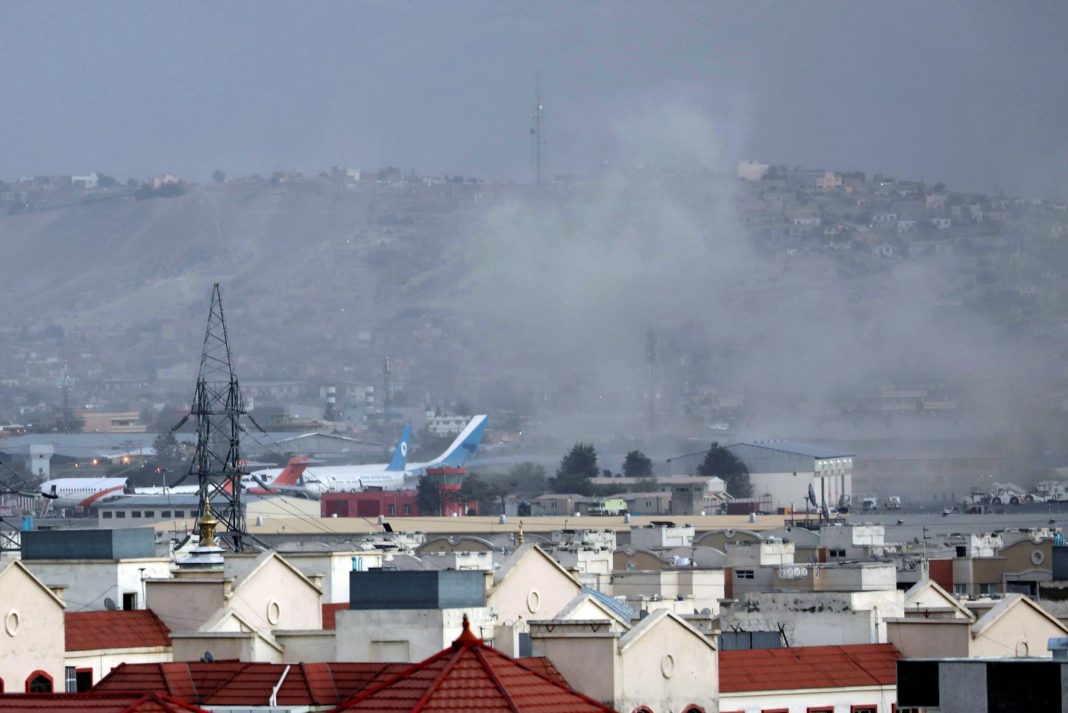US forces helping to evacuate Afghans desperate to flee Taliban rule are on alert for more attacks after at least one Islamic State suicide bomber killed 85 people including 13 US soldiers outside the gates of Kabul airport.
Two blasts and gunfire rocked the area outside the airport on Thursday evening, witnesses said. Video shot by Afghan journalists showed dozens of bodies strewn around a canal on the edge of the airport.
A health official and a Taliban official said the toll of Afghans killed had risen to 72, including 28 Taliban members, although a Taliban spokesman later denied that any of their fighters guarding the airport perimeter had been killed.
The US military said 13 of its service members were killed and 18 wounded in what it described as a complex attack.
Islamic State (ISIS), an enemy of the Islamist Taliban as well as the West, said one of its suicide bombers targeted “translators and collaborators with the American army”.
It was not clear if suicide bombers detonated both blasts or if one was a planted bomb. It was also not clear if ISIS gunmen were involved in the attack or if the firing that followed the blasts was Taliban guards firing into the air to control crowds.
General Frank McKenzie, head of US Central Command, said US commanders were watching for more attacks by Islamic State, including possibly rockets or car bombs targeting the airport.
“We’re doing everything we can to be prepared,” he said, adding that some intelligence was being shared with the Taliban and that he believed “some attacks have been thwarted by them.”
US forces are racing to complete their withdrawal from Afghanistan by an August 31 deadline set by President Joe Biden.
He says the United States long ago achieved its original rationale for invading the country in 2001: to root out al Qaeda militants and prevent a repeat of the September 11 attacks on the United States that year.
Biden said he had ordered the Pentagon to plan how to strike ISIS-K, the Islamic State affiliate that claimed responsibility.
“We will not forgive. We will not forget. We will hunt you down and make you pay,” Biden said during televised comments from the White House.
Video of the attack showed corpses in a waste water canal by the airport fence, some being fished out and laid in heaps while wailing civilians searched for loved ones.
“I saw bodies and body parts flying in the air like a tornado blowing plastic bags,” said one Afghan witness. “That little water flowing in the sewage canal had turned into blood.”
British Defence Secretary Ben Wallace said the threat of attacks would increase as Western troops got closer to completing the huge airlift and leaving.
“The narrative is always going to be, as we leave, certain groups such as ISIS will want to stake a claim that they have driven out the US or the UK,” Wallace told Sky News.
ISIS-K was initially confined to areas on the border with Pakistan but has established a second front in the north of the country. The Combating Terrorism Centre at West Point says ISIS-K includes Pakistanis from other militant groups and Uzbek extremists in addition to Afghans.
Western countries fear the Taliban, who once sheltered Osama bin Laden’s al Qaeda before it was ousted from power by the US-led 2001 invasion, will allow Afghanistan to turn again into a haven for militants. The Taliban say they will not let the country be used by terrorists.
The US will press on with evacuations despite the threat of further attacks, McKenzie said, noting there were still about 1000 US citizens in Afghanistan.
In the past 12 days, Western countries have airlifted nearly 100,000 people. But they acknowledge that thousands will be left behind when the last US troops leave at the end of the month.
Worries are growing that the remaining population will face a humanitarian crisis with the coronavirus spreading and shortages of food and medical supplies looming.
The World Health Organisation said it hoped to establish an air bridge into the northern city of Mazar-i-Sharif with the help of Pakistani authorities to get medical supplies in.
AAP
Read more:



